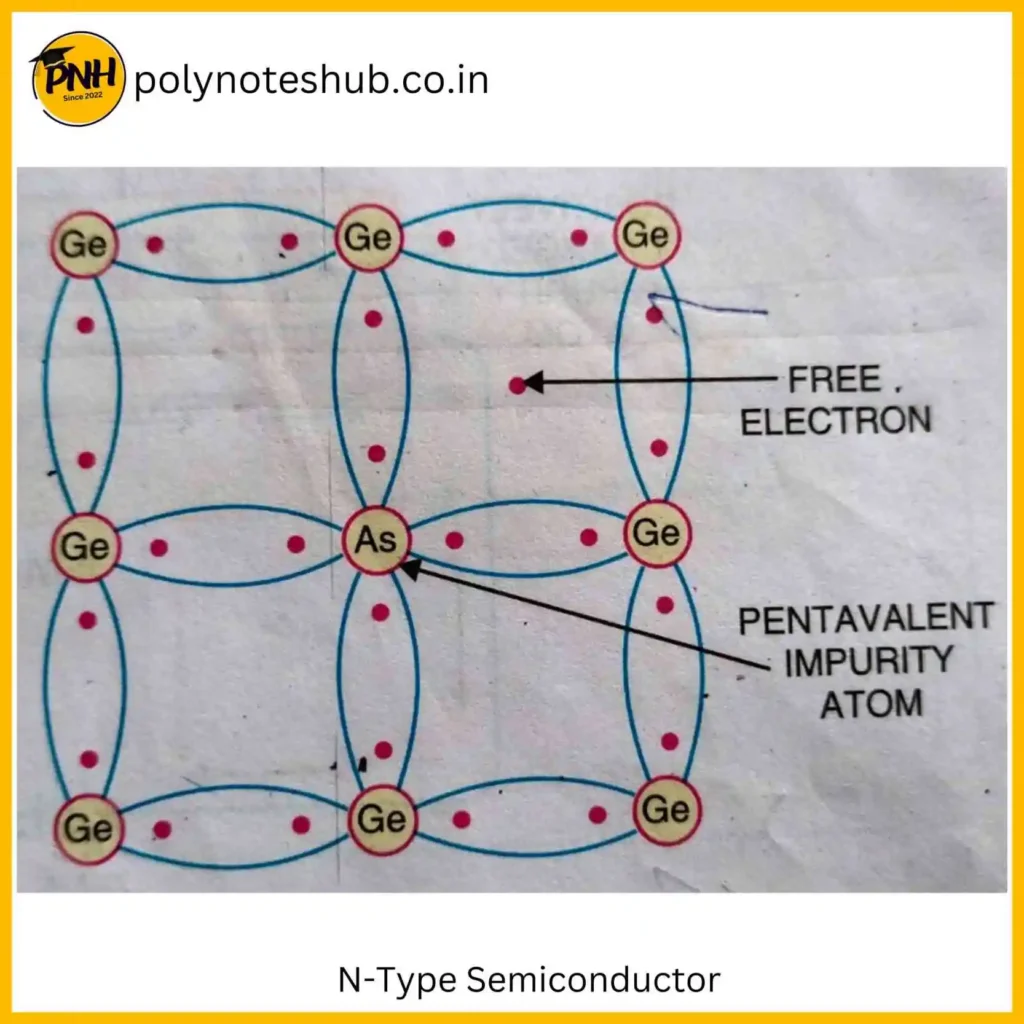In this article, we are discussing n type and p type semiconductors. This is one of the important topics for Diploma Engineering Students. Ploy Notes Hub loves to share this topic with all of you. Before learning this content, you have to gather knowledge about the Semiconductor. To learn, Click Here.
Introduction
There are two types of semiconductor
- Intrinsic Semiconductor
- Extrinsic Semiconductor
And the Extrinsic Semiconductor is also divided into two categories
- n-type semiconductor
- p-type semiconductor
N Type and P Type Semiconductor
Below, we discuss the N-Type and P-Type Semiconductors with internal structure.
N-Type Semiconductor
When a small amount of pentavalent is added to a pure semiconductor, it is known as an n-type semiconductor.
The addition of pentavalent impurity provides a large number of free electrons in the semiconductor crystal. Typical pentavalent impurities are arsenic (At. No. 33) and antimony (At. No. 51). Such Impurities that produce n-type semiconductors are known as donor impurities because they donate or provide free electrons to the semiconductor crystal.

To explain the formation of n-type semiconductors, consider a pure germanium crystal. We know that the germanium atom has four valence electrons. When a small amount of pentavalent impurity like arsenic is added to germanium crystal, a large number of free electrons become available in the crystal. The reason is simple. Arsenic is pentavalent i.e. its atom has five valence electrons.
An arsenic atom fits in the germanium crystal so that its four valence electrons form covalent bonds with four germanium atoms. The fifth valence electrons of the arsenic atom find no place in co-valent bonds and are thus free as shown in the above figure. Therefore, one free electron will be available in the germanium crystal for each arsenic atom added. Though each arsenic atom provides one free electron, an extremely small amount of arsenic impurity provides enough atoms to supply millions of free electrons.
Majority and Minority carriers
This type of semiconductor produces a large number of free electrons and a few number holes are also created by it. For this reason, Electrons are the Majority Carrier in this type of Semiconductor and Holes are the Minority Carrier in this type of Semiconductor.
P-Type Semiconductor
When a small amount of trivalent impurity is added to a pure semiconductor, it is called a p-type semiconductor.
The addition of trivalent impurity provides a large number of holes in the semiconductor. Typical examples of trivalent impurities are gallium (At. No. 31) and indium (At. No. 49). Such Impurities that produce p-type semiconductors are known as acceptor impurities because the holes created can accept the electrons.

To explain the formation of a p-type semiconductor, consider a pure germanium crystal. When a small amount of trivalent impurity like gallium is added to germanium crystal, there exists a large number of holes in the crystal. The reason is simple. Gallium is trivalent i.e. its atom has three valence electrons. Each atom of gallium fits into the germanium crystal but now only three covalent bonds can be formed. It is because three valence electrons of a gallium atom can form only three single covalent bonds with three germanium atoms as shown in the above figure.
In the fourth co-valent bond, only the germanium atom contributes one valence electron while gallium has no valence electron to contribute as all its three valence electrons are already engaged in the covalent bonds with neighboring germanium atoms. In other words, the fourth bond is incomplete; being short of one electron. This missing electron is called a hole. Therefore, for each gallium atom added, one hole is created. A small amount of gallium provides millions of holes.
Majority and Minority carriers
This type of semiconductor produces a large number of holes and a few number electrons are also created by it. For this reason, Holes are the Majority Carrier in this type Semiconductor and Electrons are the Minority Carrier in this type Semiconductor.
Difference between N-Type and P-Type Semiconductor
| N-Type | P-Type |
|---|---|
| 1. It requires pentavalent impurity. | 1. It requires trivalent impurity. |
| 2. The majority Carriers are Electrons. | 2. The majority Carriers are Holes. |
| 3. The minority Carriers are Holes. | 3. The minority Carriers are Electrons. |
| 4. Conductivity dependent on electrons. | 4. Conductivity dependent on holes. |
| 5. Added impurities are – Arsenic and Antimony. | 5. Added impurities are – Gallium and Indium. |
Conclusion | Diploma Engineering Notes | Poly Notes Hub
Our Poly Notes Hub provides syllabus-wise notes for polytechnic or diploma engineering students of streams like Electrical Engineering, Electronics Engineering, Electronics and Tele-Communication Engineering, Electrical and electronics Engineering, Electronics & Instrumentation Engineering, and Computer Science & Technology. Our website is updating day by day so keep in touch with us for new and syllabus-wise notes and topic which helps you all to do any task regarding diploma engineering.
